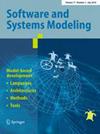结合符号执行和频谱分析的DSLTrans模型转换故障定位
IF 3.2
3区 计算机科学
Q3 COMPUTER SCIENCE, SOFTWARE ENGINEERING
引用次数: 0
摘要
模型转换的验证是实现鲁棒模型驱动工程技术和质量保证自动化的重要手段。人们提出了许多检查模型转换属性的方法。其中大多数侧重于通过合同检查有效和高效地发现财产侵权行为。然而,在基于验证反馈识别转换的失败契约和精确识别错误规则之间仍然存在错误定位步骤。虽然在模型转换验证文献中存在故障定位方法,但这些方法需要创建和维护测试用例,这给开发人员带来了额外的负担。本文将基于符号执行的转换验证与基于谱的故障定位技术相结合,用于识别DSLTrans模型转换中的故障规则。这种故障定位方法使用符号变换检查器的路径条件输出,而不需要一组测试输入模型。特别地,我们引入了一个工作流,用于运行模型转换的符号执行,评估定义的契约的满意度,以及计算跟踪错误规则的不同度量。我们评估了基于频谱的分析技术用于跟踪错误规则的有效性,并将我们的方法与以前的工作进行了比较。我们通过在五个模型转换中引入已知的突变来评估我们的技术。我们的结果表明,最好的基于频谱的分析技术允许有效的故障定位,显示平均考试分数低于0.30(少于30%的转换需要检查)。这些技术还能够在70%的情况下将错误规则定位在排名前三的规则中。讨论了模型变换、突变类型和契约类型对结果的影响。最后,我们还研究了该技术不能正常工作的情况,包括讨论潜在的预检查,以估计该技术对某个转换的前景。本文章由计算机程序翻译,如有差异,请以英文原文为准。

Fault localization in DSLTrans model transformations by combining symbolic execution and spectrum-based analysis
Abstract The verification of model transformations is important for realizing robust model-driven engineering technologies and quality-assured automation. Many approaches for checking properties of model transformations have been proposed. Most of them have focused on the effective and efficient detection of property violations by contract checking. However, there remains the fault localization step between identifying a failing contract for a transformation based on verification feedback and precisely identifying the faulty rules. While there exist fault localization approaches in the model transformation verification literature, these require the creation and maintenance of test cases , which imposes an additional burden on the developer. In this paper, we combine transformation verification based on symbolic execution with spectrum-based fault localization techniques for identifying the faulty rules in DSLTrans model transformations. This fault localization approach operates on the path condition output of symbolic transformation checkers instead of requiring a set of test input models. In particular, we introduce a workflow for running the symbolic execution of a model transformation, evaluating the defined contracts for satisfaction, and computing different measures for tracking the faulty rules. We evaluate the effectiveness of spectrum-based analysis techniques for tracking faulty rules and compare our approach to previous works. We evaluate our technique by introducing known mutations into five model transformations. Our results show that the best spectrum-based analysis techniques allow for effective fault localization, showing an average EXAM score below 0.30 (less than 30% of the transformation needs to be inspected). These techniques are also able to locate the faulty rule in the top-three ranked rules in 70% of all cases. The impact of the model transformation, the type of mutation and the type of contract on the results is discussed. Finally, we also investigate the cases where the technique does not work properly, including discussion of a potential pre-check to estimate the prospects of the technique for a certain transformation.
求助全文
通过发布文献求助,成功后即可免费获取论文全文。
去求助
来源期刊

Software and Systems Modeling
工程技术-计算机:软件工程
CiteScore
6.00
自引率
20.00%
发文量
104
审稿时长
>12 weeks
期刊介绍:
We invite authors to submit papers that discuss and analyze research challenges and experiences pertaining to software and system modeling languages, techniques, tools, practices and other facets. The following are some of the topic areas that are of special interest, but the journal publishes on a wide range of software and systems modeling concerns:
Domain-specific models and modeling standards;
Model-based testing techniques;
Model-based simulation techniques;
Formal syntax and semantics of modeling languages such as the UML;
Rigorous model-based analysis;
Model composition, refinement and transformation;
Software Language Engineering;
Modeling Languages in Science and Engineering;
Language Adaptation and Composition;
Metamodeling techniques;
Measuring quality of models and languages;
Ontological approaches to model engineering;
Generating test and code artifacts from models;
Model synthesis;
Methodology;
Model development tool environments;
Modeling Cyberphysical Systems;
Data intensive modeling;
Derivation of explicit models from data;
Case studies and experience reports with significant modeling lessons learned;
Comparative analyses of modeling languages and techniques;
Scientific assessment of modeling practices
 求助内容:
求助内容: 应助结果提醒方式:
应助结果提醒方式:


